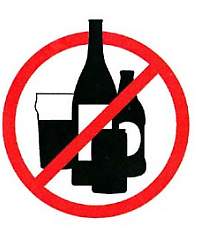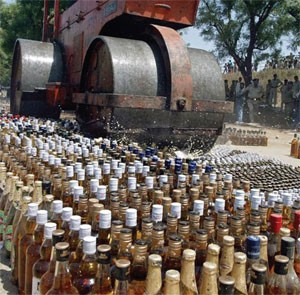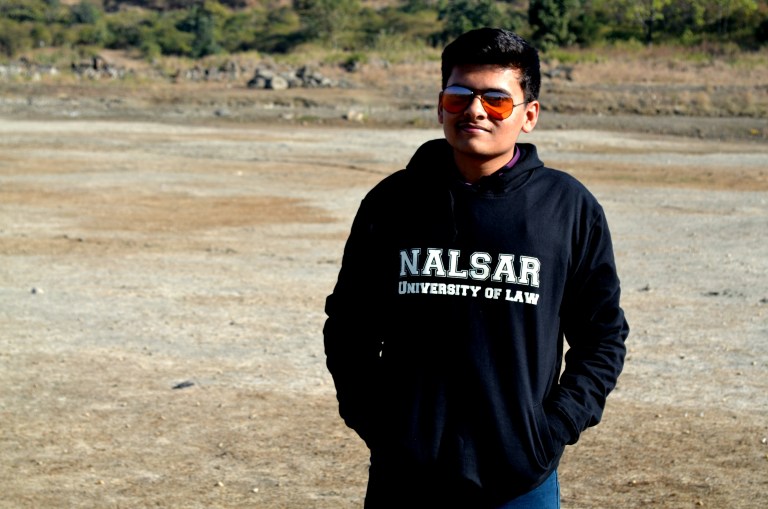In this Blog post, Abhiraj Thakur, 1st-year student NALSAR University of Law, Hyderabad, writes about the efficiency of complete bans on alcohol consumption.
Bans on alchohol are usually implemented keeping in mind certain goals to be achieved but are these bans able to achieve them, or on the contrary they adversely affect the economy of the state? In this regard, a look at the present laws that completely ban alcohol is necessary. These laws are in force inter alia in states of Mizoram and Nagaland. Let’s look at the consequences of such laws in these two states.
 Prohibition simply means the prevention by the law of the manufacture and sale of alcohol. A dry state is a state where prohibition is applied, and that is a state in which the manufacture, distribution, import, and sale of alcoholic drinks are prohibited. Until very recently, four Indian states were dry states; namely Gujarat, Manipur, Nagaland, and Mizoram. However, about 2 yrs back on July 10, 2014, Mizoram replaced the Mizoram Liquor (Total Prohibition) Act of 1995 (MLTP) and with the Mizoram Liquor (Prohibition and Control) Bill 2014 (MLPC).[1] Following this policy change in Mizoram, the Nagaland government is in a constant tussle on lifting the Nagaland Total Liquor Prohibition Act of 1989.[2]
Prohibition simply means the prevention by the law of the manufacture and sale of alcohol. A dry state is a state where prohibition is applied, and that is a state in which the manufacture, distribution, import, and sale of alcoholic drinks are prohibited. Until very recently, four Indian states were dry states; namely Gujarat, Manipur, Nagaland, and Mizoram. However, about 2 yrs back on July 10, 2014, Mizoram replaced the Mizoram Liquor (Total Prohibition) Act of 1995 (MLTP) and with the Mizoram Liquor (Prohibition and Control) Bill 2014 (MLPC).[1] Following this policy change in Mizoram, the Nagaland government is in a constant tussle on lifting the Nagaland Total Liquor Prohibition Act of 1989.[2]
To get the answer to the question of whether such blanket-ban really helps we need to analyze the reasons and the consequences of prohibition in the sale and consumption of alcohol – the factors that necessitate total ban, whether total ban is efficient in achieving the objective of the ban and other viable measures for attaining the said objective.
Few Reasons For BAN
Health Reasons
A majority of alcoholic beverages are addictive, containing the same mood-changing agent – ethyl alcohol, in varying percentages. About 10 to 15% of alcohol users develop alcohol dependence and become alcoholics, making excessive alcohol consumption a grave problem for society.[3] Primarily, alcohol consumption causes two adverse effects. Firstly, alcohol is a toxic substance and the root of many health problems. It affects every organ of the body causing slurred speech, loss of balance, vomiting, severe sensory impairment, unconsciousness, stomach cancer, liver cirrhosis, damage to brain cells, damage to blood vessels and the like; resulting in death if consumed heavily.
Increasing Crime Rates
Secondly, alcohol consumption is the cause of many crimes – those committed under the influence of intoxication and those committed to obtaining the money to sustain habitual alcoholism. Crimes such as rash driving, road accidents, suicides, attempts to commit suicide, domestic violence, spousal abuse, violence towards children and elderly are often linked to alcohol consumption.
Religious Reasons
The inhabitants of Nagaland and Mizoram are mainly Christian. The church as an institution has a significant influence on the masses – the power to mobilize people around the views propounded by it; as can be seen in the mass-based organizations that vehemently defend prohibition of alcohol at the Church’s behest. It’s a powerful force in the political arena and holds sway over the regulations that control the sale of alcohol. This is evident in the reaction of the Church to the lifting of the total ban on alcohol in the state of Mizoram. The Bible condemns consumption of liquor, Proverbs 23:21, “The drunkards shall come to poverty.” There is a strong opposition by the Church towards any sale and consumption of alcohol.
Keeping in mind the adverse consequences of alcohol consumption and religious morals, the government spends substantial amount each year on regulating or reducing the flow of alcohol in the country mainly by way of prohibition, taxation, and restricting access by age-bars. The objective of such control-mechanisms is to reduce the degradation of health among the people and to reduce alcohol-related crimes. The government of Mizoram and Nagaland adopted the method of total prohibition.
Understanding Efficacy of Such Blanket-Bans
There’s Still Alcohol….
The Mizoram Liquor Total Prohibition Act of 1996 completely outlawed the sale and consumption of alcohol. But, few exceptions such as provisions for issuing permits for health grounds and for ex-army officials existed. Despite this total ban, alcohol is till today easily found in the state. On-ground surveys reveal that country liquor and Indian Made Foreign Liquor (IMFL) are freely available at Rangvamual and Phunchawng, west of Aizawl.[4]
Near the foothills of Aizwal, the capital of Mizoram, there are rows of shacks serving the local brew called ‘zu.’ Hundreds of locals ride down to drink liquor in these watering holes.[5] From February 20, 1997, the date the ban was imposed, till April 30 of 2011, the number of people arrested for illegal sale of alcohol was 36,913, of which 27,123 were convicted. These official figures from state excise and narcotics department records could be much lower than the actual number.[6] A total ban coupled with high demand leads to a flourishing moonlighting and bootlegging business. The downside being that there is a lack of any government regulated or monitored sale of alcohol – the sellers have no standards to adhere to. Hence, the sale of spurious adulterated liquor abounds. Consumption of this alcohol leads to many aggravated liver disease, often leading to death.
The Economy is in gallows…
During dry days, the government earns no excise duty from sale of alcohol, since the sale is illegal – naturally the total revenue of the state decreases. However, to enforce the ban, the government needs to allocate more resources in terms of law enforcement officials. Hence, there is a decrease in the total revenue but an increase in the demand for resources for the enforcement of the ban – the government faces a deficit.[7]
Also Such Bans have Other Consequences
The government of Any state that brings in such laws needs to take into account the effects of such a ban on other facets of society. For instance in Mizoram, The ban directly hits employees in breweries and vineyards as well as grape farmers. Grape farming is very prevalent in the hilly regions of the Northeast India. The state of Mizoram produced around 20,800 tons of grapes in 2012-13. Due to pressure from grape farmers, the government has allowed production of local grape wine in certain parts of the state. Army personnel and the Para-military forces, forming a significant portion of the population, have a high demand for liquor. Bowing to pressure, the government was compelled to give liquor licenses to 12 army units.
Due to pressure from grape farmers, the government has allowed production of local grape wine in certain parts of the state. Army personnel and the Para-military forces, forming a significant portion of the population, have a high demand for liquor. Bowing to pressure, the government was compelled to give liquor licenses to 12 army units.[8] In fact, a large number of studies over a period of time have shown that awareness policies are a better method to control alcohol-related issues. A large number of anthropologists around the globe however believe that not from BAN but With alcohol-awareness policies, the consumption of alcohol and alcohol-related crime both diminish in the long run.
In fact, a large number of studies over a period of time have shown that awareness policies are a better method to control alcohol-related issues. A large number of anthropologists around the globe, however, believe that not from BAN but With alcohol-awareness policies, the consumption of alcohol and alcohol-related crime both diminish in the long run.
In fact, a large number of studies over a period of time have shown that awareness policies are a better method to control alcohol-related issues. A large number of anthropologists around the globe, however, believe that not from BAN but With alcohol-awareness policies, the consumption of alcohol and alcohol-related crime both diminish in the long run.[9] From the data available from the two states, the picture becomes clear that the governments have to increase their spending to a great extent to enforce the ban. This is in turn detrimental to the common populace as that money could have been utilized in a more efficient way by educating people about the harmful effects of alcohol.
Conclusion
Many states in India today face constant dilemmas on the issue of banning alcohol. By going through the consequences of total ban on alcohol, the picture becomes clear that a total eradication on the sale of alcohol is not the most efficient solution – it does not fully attain its aim of reducing alcohol consumption. The resources required for effective implementation of a total ban are not available to most of the states in India. The high demand for alcohol, easy supply from neighboring states and the inability or unwillingness of the state governments to spare enough resources make the enforcement of prohibition futile. In such circumstances, the more viable method of reducing alcohol intake would be regulation through taxation coupled with the policies of alcohol-education. Not only does the state gain revenue from sale of alcohol but also alcohol-related deaths decrease. In the long run, these policies decrease the demand for alcohol and in so doing achieve the aim of reduced alcohol consumption.
[divider]
Footnotes:
[1] Adam Halliday, “Mizoram lifts 18-year-old ban on alcohol” The Indian Express, July 10, 2014 available, at http://indianexpress.com/article/india/india-others/mizoram-lifts-18-year-old-ban-on-alcohol/
[2] “Nagaland government open to discussion on lifting liquor ban” DNA India, July 24, 2014 available, at http://www.dnaindia.com/india/report-nagaland-government-open-to-discussion-on-lifting-liquor-ban-in-state-2004999
[3] “Alcohol related harm in India – a fact sheet” available at http://www.addictionindia.org/images-ttkh/alcohol-related-harm-in-india-a-fact-sheet.pdf
[4] “Looking for a peg” Indian Express, June 22, 2014 available, at http://indianexpress.com/article/india/india-others/looking-for-a-peg/
[5] “POST-DRY STATE STATUS: Mizoram hoping to earn Rs 30 crore more revenues” The Morung Express, July 19, 2014 available, at http://www.morungexpress.com/regional/118970.html
[6] “Prohibition a ‘failure’ in Mizoram” The Indian Express July 11, 2011 available, at http://archive.indianexpress.com/news/prohibition-a-failure-in-mizoram/815843/
[7] “POST-DRY STATE STATUS: Mizoram hoping to earn Rs 30 crore more revenues” The Morung Express, July 19, 2014 available, at http://www.morungexpress.com/regional/118970.html
[8] “Mizoram likely to lift liquor ban, draft bill in house soon” The Times of India, February 11, 2014 available, at http://timesofindia.indiatimes.com/city/guwahati/Mizoram-likely-to-lift-liquor-ban-draft-bill-in-house-soon/articleshow/30206676.cms
[9] Under these circumstances there is also a reduction in the total revenue generated from the sale of alcohol. However, a policy of alcohol-awareness requires a large initial investment. Subsequently the investment needed to continue educating young masses on the ills of alcohol consumption reduces. Hence, it can be balanced with the loss in the total revenue over time.











